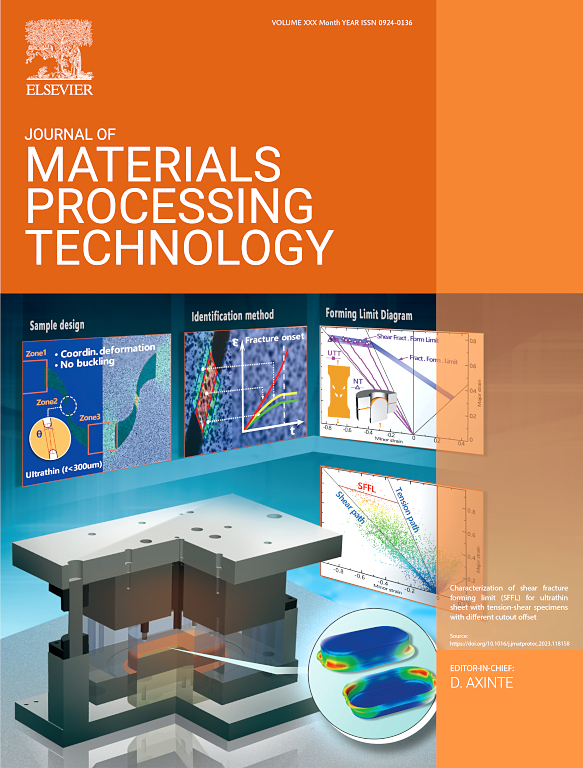协同双面无探针搅拌摩擦点焊:刀具旋转方式对接头形成及强化机制的影响
IF 7.5
2区 材料科学
Q1 ENGINEERING, INDUSTRIAL
Journal of Materials Processing Technology
Pub Date : 2025-09-11
DOI:10.1016/j.jmatprotec.2025.119063
引用次数: 0
摘要
本研究系统地研究了2198-T8铝锂合金板的双面协同搅拌摩擦点焊(SDP-FSSW)。通过独立控制两刀肩的旋转方式,探索了单侧旋转、同向旋转和反向旋转三种焊接构型。宏观和微观结构分析表明,共旋转产生振荡波钩,有效抑制界面裂纹扩展,即使没有停留,其抗拉剪切强度也超过10 kN,并在3 s时达到13.38 kN的峰值。在反向旋转中,相反的物质流形成向上和向下翘曲的挂钩,显著增加了有效承载面积,抗拉剪切强度在6 s时达到最大值15.10 kN。这些结果表明,SDP-FSSW有效地解决了传统点焊铝合金中冶金结合和几何缺陷恶化之间的权衡问题,既改善了界面结合,又增强了接头稳定性。这项研究提供了一种实现高性能点焊的新方法,特别是在轻型结构应用中。本文章由计算机程序翻译,如有差异,请以英文原文为准。
Synergistically double-sided probeless friction stir spot welding: The effect of tool rotation modes on joint formation and strengthening mechanisms
This study systematically investigates the synergistically double-sided probeless friction stir spot welding (SDP-FSSW) applied to 2198-T8 Al–Li alloy sheets. By independently controlling the rotation modes of two tool shoulders, three welding configurations—single-sided rotation, co-rotation, and counter-rotation—were explored. Macro- and microstructural analysis revealed that co-rotation produces an oscillating wavy hook, which effectively suppresses interfacial crack propagation, yielding tensile-shear strengths exceeding 10 kN—even without dwell—and reaching a peak of 13.38 kN at 3 s. In counter-rotation, opposing material flow creates upward- and downward-warping hooks that significantly increase the effective load-bearing area, with tensile-shear strength rising to a maximum of 15.10 kN at 6 s. These results demonstrate that SDP-FSSW effectively addresses the traditional trade-off between metallurgical bonding and geometric defect deterioration in spot-welded aluminium alloys, offering both improved interfacial bonding and enhanced joint stability. This study provides a novel approach to achieving high-performance spot welding, particularly for lightweight structural applications.
求助全文
通过发布文献求助,成功后即可免费获取论文全文。
去求助
来源期刊

Journal of Materials Processing Technology
工程技术-材料科学:综合
CiteScore
12.60
自引率
4.80%
发文量
403
审稿时长
29 days
期刊介绍:
The Journal of Materials Processing Technology covers the processing techniques used in manufacturing components from metals and other materials. The journal aims to publish full research papers of original, significant and rigorous work and so to contribute to increased production efficiency and improved component performance.
Areas of interest to the journal include:
• Casting, forming and machining
• Additive processing and joining technologies
• The evolution of material properties under the specific conditions met in manufacturing processes
• Surface engineering when it relates specifically to a manufacturing process
• Design and behavior of equipment and tools.
 求助内容:
求助内容: 应助结果提醒方式:
应助结果提醒方式:


